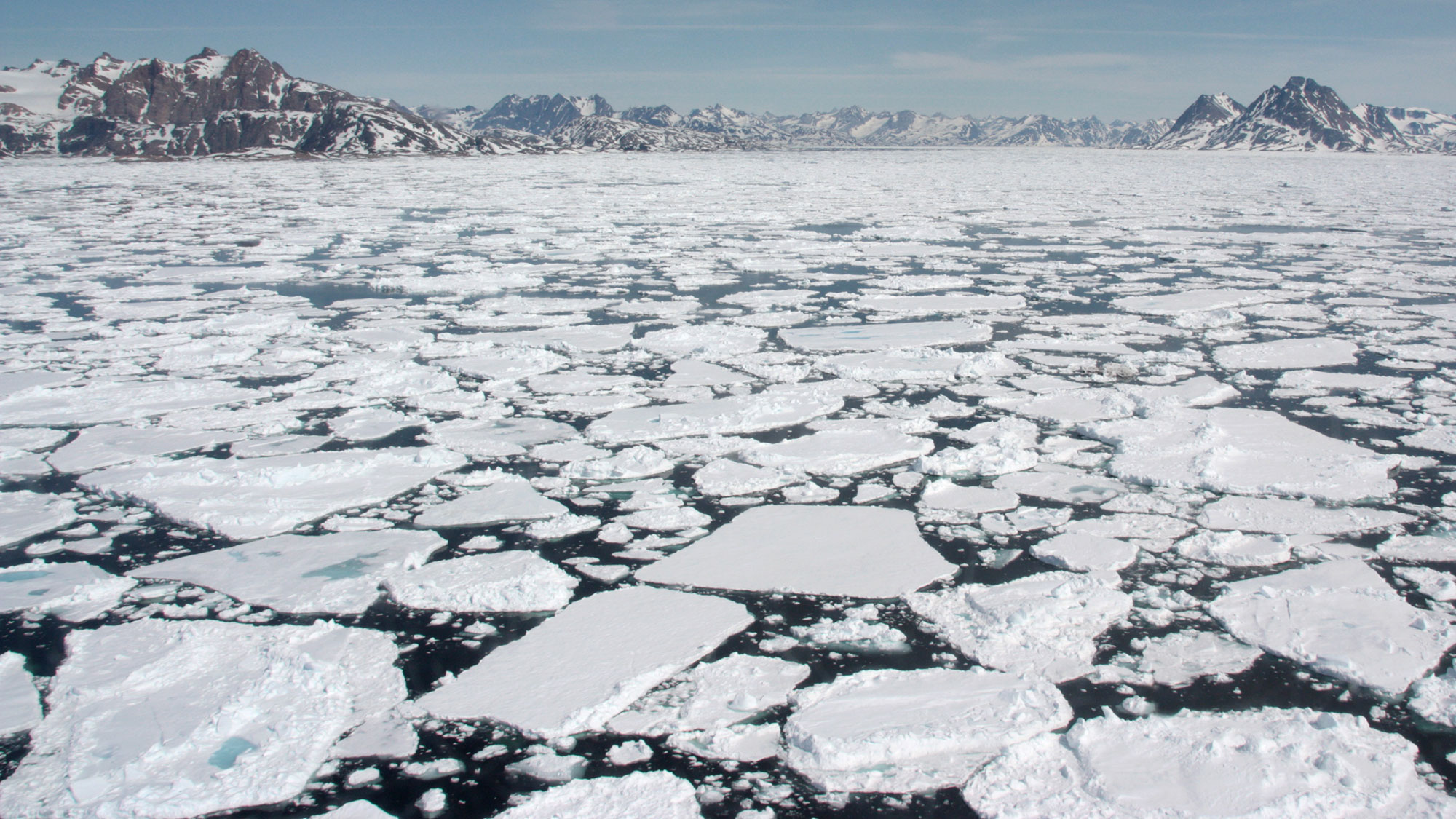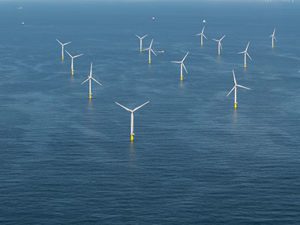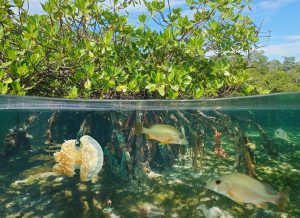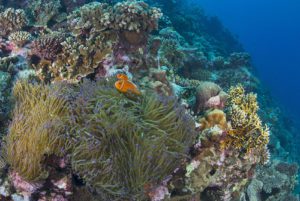As the United Nations Framework Convention on Climate Change (UNFCCC) gets underway next week, it will include for the first time a series of discussions about the role of the ocean in mitigating climate change and strengthening adaptation efforts. These conversations on December 2 and 3 are an unprecedented opportunity to lift up the power of a healthy ocean in reducing the impacts of climate change. To learn more about what we can expect from the UNFCCC dialogues and beyond, Our Shared Seas sat down with Gwynne Taraska, Director of the Climate Program at Ocean Conservancy.

Photo: iStock
What are the biggest opportunities to take action on climate and the ocean between now and the end of 2021?
There are several upcoming moments on the international stage that are important for ocean-climate progress and for climate action overall.
During the most recent U.N. climate summit, Conference of the Parties (COP) 25 in December 2019, countries adopted a first-of-its-kind decision that recognized the ocean-climate nexus and mandated a dialogue “on the ocean and climate change to consider how to strengthen mitigation and adaptation action.” That dialogue, now scheduled for December 2-3, will be a key moment to elevate ocean-climate action in the UNFCCC.
Following the UN dialogue is the fifth anniversary of the Paris Agreement (December 12), which is relevant for two reasons. First, we can expect many countries to come forward with the next iteration of their national climate goals (Nationally Determined Contributions, or NDCs) under the Paris Agreement. These should include a sharp reduction in greenhouse gas emissions, which is critical for the ocean and the communities that rely on it. Second, countries will host a Blue Climate Summit in early 2021 to take stock of the ocean-climate dialogue and discuss necessary next steps to accelerate action.
By the next U.N. climate summit (COP26), which has been delayed until November 2021, it will be clear whether countries have dramatically scaled up their climate ambition or remain off course to reach the vision of the Paris Agreement. And at the summit itself, countries will have an opportunity to adopt a COP26 decision that ensures that the dialogue was not an endpoint for ocean-climate action in the UNFCCC, but a springboard for continued work.
As the UNFCCC Climate Dialogues get underway, what will signal that conversations are moving in the right direction? What will be a successful outcome of these meetings?
Historically, the international climate effort has largely overlooked the ocean-climate nexus and the potential of ocean-based climate solutions. That is beginning to change—and the ocean-climate dialogue is a major opportunity to continue “mainstreaming” ocean issues in the climate regime.
To that end, countries should discuss the need to elevate ocean issues across the work of the UNFCCC and to incorporate sustainable ocean-based climate solutions—from scaling up offshore renewable energy to protecting and restoring blue carbon ecosystems—in their NDCs.
The dialogue will also offer the opportunity to begin “de-fracturing” ocean-climate governance more broadly. Because countries should promote ocean-climate action not only in the UNFCCC but across international fora, they should discuss how to foster communication—and coherence—among regimes, from the International Maritime Organization (IMO) to the Convention on Biological Diversity (CBD).
Lastly, countries should underline the need to ensure that there is continued momentum after the dialogue. Ocean-climate issues are life-and-death issues for many countries, including small-island developing states (SIDS), which are facing devastating storms and rising seas. The dialogue will be successful if it not only spurs near-term interest in ocean-based solutions, but lays the foundation for further action at COP26. One option is for countries to create an ongoing home for ocean-climate action under the UNFCCC—such as a recurring event that takes stock of progress going forward.
Historically, the international climate effort has largely overlooked the ocean-climate nexus and the potential of ocean-based climate solutions. That is beginning to change—and the ocean-climate dialogue is a major opportunity to continue “mainstreaming” ocean issues in the climate regime.
The dialogue will be successful if it not only spurs near-term interest in ocean-based solutions, but lays the foundation for further action at COP26. One option is for countries to create an ongoing home for ocean-climate action under the UNFCCC—such as a recurring event that takes stock of progress going forward.
What might be possible under a Biden-Harris Administration that has not been possible over the past four years? What role do you hope to see the U.S. take in these dialogues – and in international engagement and collaboration more broadly?
The Biden-Harris Administration will have the opportunity to re-establish U.S. leadership in the international climate effort. The first priority will be to rejoin the Paris Agreement. In addition, the new Administration will need to put forward an ambitious national climate target for 2030 and set the country on a path to achieve both the 2030 target and the longer-term goal of net-zero greenhouse gas pollution by 2050.
The new Administration will also have an opportunity to create a “blue-green” foreign policy. In addition to leading the effort to elevate ocean issues in the UNFCCC, the United States could set a global precedent by formulating its own ocean-climate commitments on issues such as scaling up offshore renewable energy or achieving “no net loss” of wetlands. These could be within or supplemental to the NDC for the United States.
The United States can also join and lead ocean-climate “ambition coalitions.” Because multilateral bodies such as the UNFCCC have broad membership and stringent decision-making rules, it is the role of smaller coalitions to serve as a north star for ambitious action. The Pacific Rim Ocean-Climate Action Partnership is one emerging coalition devoted to maximizing sustainable ocean-based mitigation and adaptation.
Yet another opportunity is for the United States to lead the decarbonization of the international shipping sector, which is currently responsible for greenhouse gas emissions equivalent to those of a G7 country. The UNFCCC has for a long time deferred to the IMO to address the regulation of shipping emissions, and the new Administration should become a leading force for ambition in that context. For example, the United States should commit to a global goal of decarbonizing the sector to align with the Paris Agreement, which, to have a chance of success, would mean reducing shipping emissions 100 percent by 2035.
In the lead up to COP26, what can the marine conservation community do to ensure that governments bring a high level of ambition (and action) when they gather in November 2021? Should we expect to see the ocean included in countries’ Nationally Determined Contributions (NDCs)?
We are already seeing profound climate impacts—from ocean acidification to sea level rise—with only 1.1 degrees Celsius of warming over preindustrial levels. Meanwhile, global temperatures are on track to warm an additional 2 degrees Celsius by the end of the century under current policies.
Rapid decarbonization of the global economy is critical for the ocean. The marine conservation community should support not only ocean-specific actions but an “all-of-the-above” climate strategy that pursues emissions reductions across sectors, from electricity to transportation, to achieve net-zero greenhouse gas pollution by midcentury.
Ocean-based climate solutions—including scaling up offshore renewable energy, decarbonizing the shipping sector, and protecting and restoring blue carbon ecosystems—can support this overall climate ambition. These solutions can provide 6 to 21 percent of the emissions reductions necessary to limit warming in line with the Paris Agreement, according to an analysis from the High Level Panel for a Sustainable Ocean Economy.
The first set of national climate goals under the Paris Agreement largely failed to leverage the ocean-based options for reducing greenhouse gas pollution. Although a majority of countries referenced the ocean in their NDCs, a minority discussed ocean actions as climate solutions. Fewer than 20 percent of countries with coastal blue carbon ecosystems, for example, discussed their role as carbon sinks. Going forward, we can expect to see NDCs that are more ocean-inclusive. Chile, for example, has already submitted its second NDC, which includes targets related to Marine Protected Areas and climate-smart fisheries.
The marine conservation community should support not only ocean-specific actions but an “all-of-the-above” climate strategy that pursues emissions reductions across sectors, from electricity to transportation, to achieve net-zero greenhouse gas pollution by midcentury.
What voices need to be at the table to ensure ocean-based climate solutions consider the needs of the planet and of people, particularly those who are often left out of the conversation but face the greatest impacts?
There is increasing awareness that justice is necessary for climate progress. This means not only ensuring a “just transition” to a clean energy economy for the communities that have powered our fossil fuel-based industrialization but also ensuring justice for communities that are facing social and economic inequalities as well as increased risks from climate impacts. Communities on the frontlines of climate change, including Tribes and Indigenous peoples, should be integral to the decision-making processes of ocean-climate initiatives, from scaling up offshore wind energy to creating climate-smart Marine Protected Areas. In the scope of the UNFCCC, countries should pay particular attention to the needs and positions of small-island developing states (SIDS) and least-developed countries (LDCs).
There is growing momentum in policy circles and within the conservation community to bring ocean-based solutions into the mainstream for climate action. Do you think this paradigm shift is here to stay? How can ocean advocates advance this dialogue?
The momentum over the past several years has been striking. In 2017, Fiji and Sweden launched the “Ocean Pathway” initiative, which aimed to incorporate ocean issues into the processes of the UNFCCC. In 2018, California made ocean-climate action a main pillar of the Global Climate Action Summit. In 2019, the IPCC Special Report on the Ocean and Cryosphere in a Changing Climate chronicled the disruptions to the ocean system and underscored the urgency of decarbonization. Chile subsequently hosted COP25 as a “Blue COP,” which resulted in the first ocean section in a COP decision and mandated the upcoming dialogue.
This trajectory could lead to continued ocean-based climate action and a permanent place for ocean issues in the UNFCCC, but advocates should remain engaged for the remainder of 2020 and over the course of 2021 to hold countries and the UNFCCC accountable and to ensure progress. The message should be that ocean action, far from displacing climate action, can support mitigation and adaptation globally—and deserves a home in the climate regime.
The message should be that ocean action, far from displacing climate action, can support mitigation and adaptation globally—and deserves a home in the climate regime.



